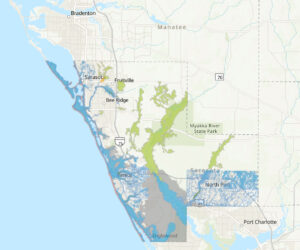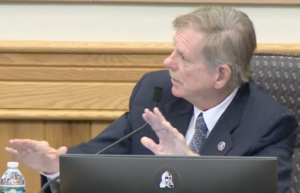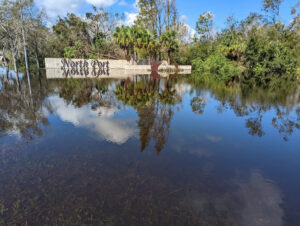Don’t hold your breath.
By Johannes Werner
Original Air Date: Nov. 22, 2023
Host: After hours of discussion on libraries, triggered by concerns over a national organization led by a self-described Marxist lesbian, Sarasota County Commissioners at their meeting last week were supposed to talk about a billion-dollar item: Whether to adopt stricter construction standards in flood zones. This was the second time staff brought the issue before them since August, seeking policy guidance from their bosses. But this was towards the end of the agenda that day, and some commissioners’ comments suggested they were not prepared. Our news team reports.
Johannes Werner: FEMA – the federal disaster management agency – has produced a new nationwide flood map. In this area, the new map moves some buildings out of the flood zone, but more buildings are moving into flood zones. To be precise, in Sarasota County a 5,300 additional buildings are now in a flood zone, with costly insurance implications for their owners.

FEMA has updated its flood map, including for Sarasota.
At the county commission meeting last week, staffers said that commissioners had to approve the FEMA map. The staffers also presented policy options, including requiring higher building elevation of new construction. The Florida building code requires one-foot “freeboard” elevation over the FEMA-set base flood level. A Florida statute allows cities and counties to go above that. But the only municipality in this region that set its own rules is the City of Bradenton Beach, which requires four feet.
The obvious advantage of raising buildings is less damage. Also, insurance companies generally charge less in cities and counties that require extra elevation, and individual owners of elevated homes get insurance discounts. The obvious disadvantage is higher construction cost.
The result of the staff presentation was a non-decision – no motion, and moving the ball to a meeting, probably in December.
However, there was some discussion.
Three commissioners – Neil Rainford, Joe Neunder and Ron Cutsinger – expressed their disinclination to new regulations. Rainford said it should be up to the builder to decide whether to elevate.
Neil Rainford: I think this is one of the things where we don’t want duplicity. We should just stick with Florida Building Code — if it says one foot, stick with one foot. And that’s all I have to say. … I don’t know how we’re going to impose what I would consider a tax on someone, if you own a lot and you want to build. Like, we’re just going to arbitrarily say six foot, 10 foot, 20 foot of additional elevation. FEMA has already made their determination with the base flood, based on recent floods, and Florida Building Code says to do one foot above that. I would think that that would be where we would need to adopt it. If anyone’s ever tried to get filler here, you’ve realized that’s a huge expense to raise that. I’m all for it, if you want to do that on your own property, you want to be 10 feet at a property … So I don’t know, us arbitrarily choosing a number, I think is a bit risky, if we haven’t done the study that FEMA has done.
Commissioner Mark Smith countered that – given local height limits – builders who decide to elevate will lose overall living space.
Surprisingly, FEMA in their latest map update lowered the overall base flood elevation by one foot.
And that worries Smith, an architect who lives on Siesta Key. He came prepared with a sketch outlining what elevating local building requirements would mean in practical terms. And he said he was concerned that FEMA’s lowering could lead to lower structures and more flood damage on barrier islands.

Mark Smith
Mark Smith: My concern … is the fact that, with FEMA lowering the base flood elevation by a foot in areas, and particularly Siesta Key, that we’re actually going to be allowing — encouraging — people to build lower than what they are right now. One of the other issues, that I don’t know if staff had an opportunity to look at, had to do with HUD. My understanding is that, for us to get HUD money, federal money for rebuilding after a storm, that the … finished-floor elevation of the houses to be rebuilt needed to be three feet above the base flood elevation by FEMA. Lowering the base flood elevation on barrier islands, I think, is a bad idea. Because we are going to be building new construction a foot lower than what it is today, and the storms aren’t getting weaker. And so that’s why I’m trying to protect new construction, as well as life, safety, and welfare.
JW: Commissioner Mike Moran, who owns an insurance agency, suggested that there should be input from the general public before commissioners decide.
Mike Moran: Anytime I’ve had to sit here, and you have to make policy decision, the most healthy ones are where you have public input. You might not like it sometimes, it might not agree with you, but it’s very healthy as far as the process. Making a quick decision from this dais is not sitting well with me on this. I want to know, the most lengthy timeline we have to hear from others on this. I want to know who it affects and who is impacted by it, and hear what they have to say about it, and I get it. The scheduled public hearings will be very helpful. … Hopefully, I’m making my point there, especially when you’re dealing with all these federal agencies, which are always the gift that keeps on giving.
JW: History suggests that without regulation, there is little change. That’s because developers rarely go above the required minimum.

North Port after Hurricane Ian. Photo: Florida Fish and Wildlife Commission
The Florida legislature has at least since 2019 pondered raising the required freeboard elevation of new construction from the one foot required, so far with no results. New Jersey and New York introduced two feet since superstorm Sandy, and in New Orleans it’s three feet.
Most remarkable during the Sarasota County commissioners’ discussion: The words “climate change” or “rising sea levels” did not come up once.
This has been Johannes Werner, reporting for WSLR.
WSLR News aims to keep the local community informed with our 1/2 hour local news show, quarterly newspaper and social media feeds. The local news broadcast airs on Wednesdays and Fridays at 6pm.